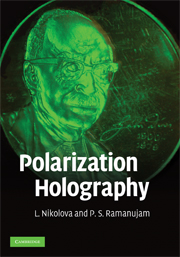Book contents
- Frontmatter
- Contents
- Preface
- List of symbols and abbreviations
- 1 Light polarization
- 2 Light propagation through polarizing systems
- 3 Theory of polarization holography
- 4 Azobenzene and azobenzene-containing polymers
- 5 Other photoanisotropic materials
- 6 Applications of polarization holography
- 7 Conclusions and future prospects
- Index
- Plate section
7 - Conclusions and future prospects
Published online by Cambridge University Press: 07 August 2009
- Frontmatter
- Contents
- Preface
- List of symbols and abbreviations
- 1 Light polarization
- 2 Light propagation through polarizing systems
- 3 Theory of polarization holography
- 4 Azobenzene and azobenzene-containing polymers
- 5 Other photoanisotropic materials
- 6 Applications of polarization holography
- 7 Conclusions and future prospects
- Index
- Plate section
Summary
Polarization holograms have been shown to possess some extraordinary properties: they are capable of achieving a 100% diffraction efficiency; and they are able to reconstruct the polarization properties of the object beam in addition to providing intensity and wavelength information. Since the reconstructed images have different polarization from that of the undiffracted light, their signal-to-noise ratio is higher than in conventional holography. Polarization holograms also exhibit achromaticity. It is possible to fabricate a half-wave plate, or a polarization beamsplitter for linearly and circularly polarized light, independently of the wavelength of operation.
Polarization holograms in materials such as alkali halides, arsenic trisulfide and bacteriorhodopsin have been used to demonstrate several interesting properties. The most efficient material available today for polarization holography is based on azobenzene. Azobenzene-containing polymers have fast response, and the polarization holograms based on azobenzene polymers are stable at room temperature. However, the fast response depends on the intensity of the interfering beams. There are other drawbacks with this material. Azobenzene absorbs blue and green light. Thus any optical element based on azobenzene can be used only in the red and infrared. While polarization holograms fabricated in azobenzene polymers have been stable over many years under ambient conditions, they are not stable under high-temperature treatment. Amorphous polymers with high glass-transition temperatures have been shown to retain light-induced anisotropy until approximately 200°C. Liquid-crystalline polymers that depend on the reorientation of entire domains are more susceptible to degradation at temperatures around 100°C.
- Type
- Chapter
- Information
- Polarization Holography , pp. 229 - 235Publisher: Cambridge University PressPrint publication year: 2009



